# Thumbnails
- One side of the screen shows one singular note in Obsidian on the graph view. The other side shows a beautiful explosion of notes from the graph view with tons and tons and tons of connections. The text says "Compound Knowledge" or "6 Months Later" Or "4600 Notes" The top right shows part 1.
# Titles
- A School Degree Isn't Enough: Differentiate Yourself With A Zettelkasten In Obsidian
# The Ultimate Beginners Guide To Starting A Zettelkasten In Obsidian As A Student Part 1
**It's not enough to go to school and get a degree anymore.**
Here's the issue: in the digital age, your perspective and ability to learn fast matters more than your rote knowledge. Not only is there more information than ever before, but new information is coming out faster than ever before. Physical colleges can't keep up.
**A physical college degree simply doesn't prepare you for the digital world anymore.**
As AI systems get better and better and more and more tasks get automated, your unique perspective as a human being is becoming increasingly important. We live in a paradox of abundance. The quality of good information is getting higher, while at the same time, the quality of bad information is getting worse.

Your hobbies, skills, abilities, relationships, and so much more combine to form something no other human being has.
The issue is traditional schooling is still built on an industrial-era model. It's trying to make you into the perfect factory worker, sucking away your unique perspective. It's making you a cookie-cutter student, the student who has no love for learning and differs in no significant way from the students around them.
We need a new type of student.
A student that loves learning for the sake of learning in itself. A student that not only can learn incredibly fast, but can imbue their own unique perspective into their notes. A student that differs fundamentally from the other students around them.
**The future belongs to the New Era Student.**

The question is how do you make the journey to become a new era student?
That's where this guide comes in.
**I'm going to teach you a system of notetaking that heightens your creativity, speed of learning, all why making school more enjoyable.**
You don't need to be a genius.
As you will see, maintaining this system can take just 15-30 minutes daily.
### Who Is This Guide For?
_Anyone who has experienced these problems:_
- Do you feel there is an **overwhelming amount of information**, and you don't know how to organize it all?
- Do you struggle to synthesize your notes into **meaningful, cohesive knowledge**?
- Are you a **student** looking to learn the **best practices, mindsets, and tools** in Obsidian to supercharge your learning?
- Do you lack a **systemized process** for notetaking?
- Do you **struggle to find enjoyment** in school learning?
- Do you feel you're not creative?
- Do you start a new semester with **no recollection** of what you learned in the last?
Do any of these sound familiar?
If so, a Zettelkasten can help.
In this ultimate beginners guide to starting a Zettelkasten we will explore:
Part 1:
- What A Zettelkasten Is
- The Benefits Of Creating One
- Introduction to The Zettelkasten Workflow In Obsidian: Idea Emergence And Collect, Connect, Create
Part 2:
- The Five Mindsets You Must Have To Create A Zettelkasten
- Deep Dive Into The Zettelkasten Workflow In Obsidian: Idea Emergence And Collect, Connect, Create
Part 3:
- Deep Dive Into The Zettelkasten Workflow (Continued)
- 3 Biggest Beginner Zettelkasten Mistakes
- 6 Tips for Maintaining a Healthy Zettelkasten
- The Zettelkasten Transformation
**This is the guide I wish I had from the start of my Zettelkasten journey. If I had started just a year earlier I can't even imagine the value I could have created for myself.**
### Who Am I?
Hi!
I'm Aidan Helfant, a Cornell Student studying psychology and creating content on the side.
As a kid, I was addicted to video games and YouTube like a fish is addicted to water.
Every day after school, I would sprint to my room faster than Usain Bolt and boot up the computer. My addiction only became worse during the start of the COVID-19 pandemic. My life became a cycle of eating, attending online classes, and playing video games.
I began to wonder what drew me so much to these virtual environments.
The reason was simple.
The real world didn't provide the carefully designed pleasures, the thrilling challenges, and the powerful social bonding I could get in games. The real world was serving me plain broccoli, while games were serving me a delicious pizza. In games, I could fully embrace my childhood curiosity and playfulness. I could explore, create, and learn to my heart's content. Compare this to my offline pursuits like school.
In contrast, school had killed my childhood curiosity.
In school, I was forced to do endless assignments, tests, essays, quizzes, and homework. **Instead of learning for the sake of learning in itself, I learned to get the best grade on the test.**
But the worst part about school, by far, was the notetaking. Notetaking brought these thoughts to my head:
- Boredom
- Sadness
- Death
Many, many students are in the same boat as me. We all have some sort of passion outside of school. For me, it was gaming. For you, it might be anime, drawing, or, if your aspire to be like Naruto, practicing martial arts. In comparison, **school doesn't provide the same level of engagement we get in our hobbies.**
The next question then became, why?
I believe one of the main reasons is students today are becoming what we call cookie-cutter students, the student who has no love for learning and differs in no significant way from the students around them.
Tell me if this sounds familiar, like a bad case of deja-vu: taking notes in class, I would copy exactly what the professor said verbatim. To study for tests later on, I would read my notes passively. For most of my life, I was a cookie-cutter student.
Until I found the Zettelkasten system of notetaking in Obsidian.
Building a Zettelkasten allowed me to make the transformation to the New Era Student. I no longer felt the need to play video games. Real life was the most fun game imaginable.
Using my Zettelkasten in Obsidian, I have created all of this in just two years:
- 170 YT videos
- 550 literature notes
- 60 Newsletters
- 60 Blog Posts
- 10 School MOCs
- 15 Non-School MOCs
- 30 Podcast Episodes
What my notes looked like before and after the Zettelkasten transformation:

Now you can do the same. I'm going to show you how to build a Zettelkasten in Obsidian yourself by summarizing what I have learned over 100s of hours of experience and reflection, taking multiple courses in the PKM community like Building a Second Brain, Build Your Knowledge Portfolio, and The Linking Your Thinking Workshop. The best part is once the system is set up, all it takes to maintain is a simple 15-30 minute a day check-in.
- Your daily coffee run. ☕
- Or your nightly shutdown. 🌜
- Or your daily peanut butter snack 🥜
**Let's make the same transformation for you.**
### What is a Zettelkasten?
_"Creativity is just connecting things. When you ask creative people how they did something, they feel a little guilty because they didn't really do it; they just saw something."_ - STEVE JOBS
A Zettelkasten (German for "slip box" or "card index") is a note-taking and knowledge management system developed by German sociologist Niklas Luhmann in the early 20th century.
At its core, a Zettelkasten is a collection of three main types of notes: fleeting notes (notes on fleeing thoughts), literature notes (notes taken from resources like books, articles, etc.), and permanent notes--which I have rebranded as concept notes (notes with one focal idea that often have literature notes backing them up). You don't have to remember these three types of notes now. We will discuss them in depth later. At it's core the Zettelkasten works by using fleeting notes and literature notes to create permanent notes that connect together over months and years forming a knowledgebase that compounds over time.
**Using the system, Luhman was what can only be described as "disgustingly prolific."**
Over the course of his career, Luhmann created an extensive Zettelkasten containing tens of thousands of individual notes and writing 70 books and hundreds of articles and essays.
Holy smokes. 🌶️
### The Benefits of Creating a Zettelkasten
1. **It makes you more engaged in your learning.** You add your own unique personality, flare, PIZAZZZZZZ into your learning. Your knowledge becomes something no other student has. You add your own unique sauce to your burger.
2. **It promotes critical thinking.** A Zettelkasten helps students discover relationships between concepts by connecting ideas through links or references. This promotes the synthesis of knowledge, fostering a holistic understanding of a subject
3. **Creativity and idea generation.** The non-linear nature of a Zettelkasten encourages creative thinking and idea generation. Students can explore new connections, spark insights, and generate innovative ideas by engaging with their notes in a flexible and interconnected manner. Over weeks, months, and years of using a Zettelkasten ideas for what to write about naturally arise. You won't have writers block again.
4. **Reduced studying.** The brain doesn't learn by siloing information into rigid folders. It learns by connecting new information to past information. Emulating this process using a Zettelkasten means you learn the material better the first time.
5. **Never start from scratch again.** Through connecting, your notes will start to connect class to class, semester to semester. Your knowledge will compound on itself over time creating beautiful new ideas. This will continue even after you graduate. Your Zettelkasten only grows in value the more time that has passed.
6. **You allow your past, present, and future selves to work together.** Notetaking is time travel. When you take notes and connect them to ideas you had in the past, you make open yourself up to using your past self's work for your present self. Marking down a book in the moment, you might not know what it's going to be used for. But years from then, you might go back to that note and find it incredible for something you are working on.
### Why Obsidian?
Nikolas Luhman's Zettelkasten was fully analog, and out of all the tons of modern-day knowledge management apps we could choose from, why Obsidian?
I have made my PKM journey from Google Keep to Notion, to Evernote, to Roam Research, and finally to Obsidian. I have been around the block and back with notetaking apps. Of course, I'm a little biased, but by far the best one I have used is Obsidian.
Obsidian makes me feel free, alive, godly.
There are five main reasons:
1. It's way easier to maintain than a physical Zettelkasten
2. It's incredibly customizable
3. Its link based system allows you to scale knowledge across semesters
4. You own your knowledge
5. The community is incredible
**1. It's way easier to maintain than a physical Zettelkasten.**
You don't have to write down everything by hand.
You don't have to buy a literal warehouse to store your notes. The most space your Obsidian database takes is few megabytes on your local hard drive.
**2. The customizability is incredible.**
Obsidian is essentially just notes connected to other notes.
But through adding core and community plug-ins to your vault, as well as creating your own linking, tag, and folder system, you can create an entirely personal system of knowledge management.
**3. Obsidian organizes notes through links.**
The brain doesn't memorize things by siloing them off into individual folders in your head.
It connects things together. So why would you not do the same in your notetaking system? Linked-based systems allow you to write notes the same way your brain organizes things.
But they also allow you the flexibility to organize with more traditional methods like folders, tags, and queries depending on your needs.
**4. You own your knowledge.**
All your files in Obsidian are stored as plain text markdown documents on your computer hard drive.
You also have the ability to sync across different devices if you so choose. This makes your notetaking system [[Antifragile]], it gains from disorder.
If Obsidian--or the whole world for that matter--blows up, you can take knowledge knowing that your notes are safe.
**5. The community is incredible**.
Almost everyone I have met in the Obsidian community is kind-hearted and committed to helping others flesh out their PKM systems.
The community discord is active. [Nick Milo](https://www.youtube.com/@linkingyourthinking), in my opinion, the Godfather of the Obsidian community, hosts regular [Linking Your Thinking Workshops](https://www.linkingyourthinking.com/) where he teaches people the basics of PKM in Obsidian in general which I have personally participated in and loved. The plug-in developers are constantly at work creating and refining plug-ins for Obsidian.
And, of course, you can't forget the content creators like me.
## Setting Up Obsidian
Now that you know why Obsidian is such a great spot for a Zettelkasten, let's set yours up right now.
**It will literally take 3 minutes.**
As your symbolic new school teacher, here's your first assignment.
**1. Download and install Obsidian.**
Go to [https://obsidian.md/](https://obsidian.md/) in your web browser.
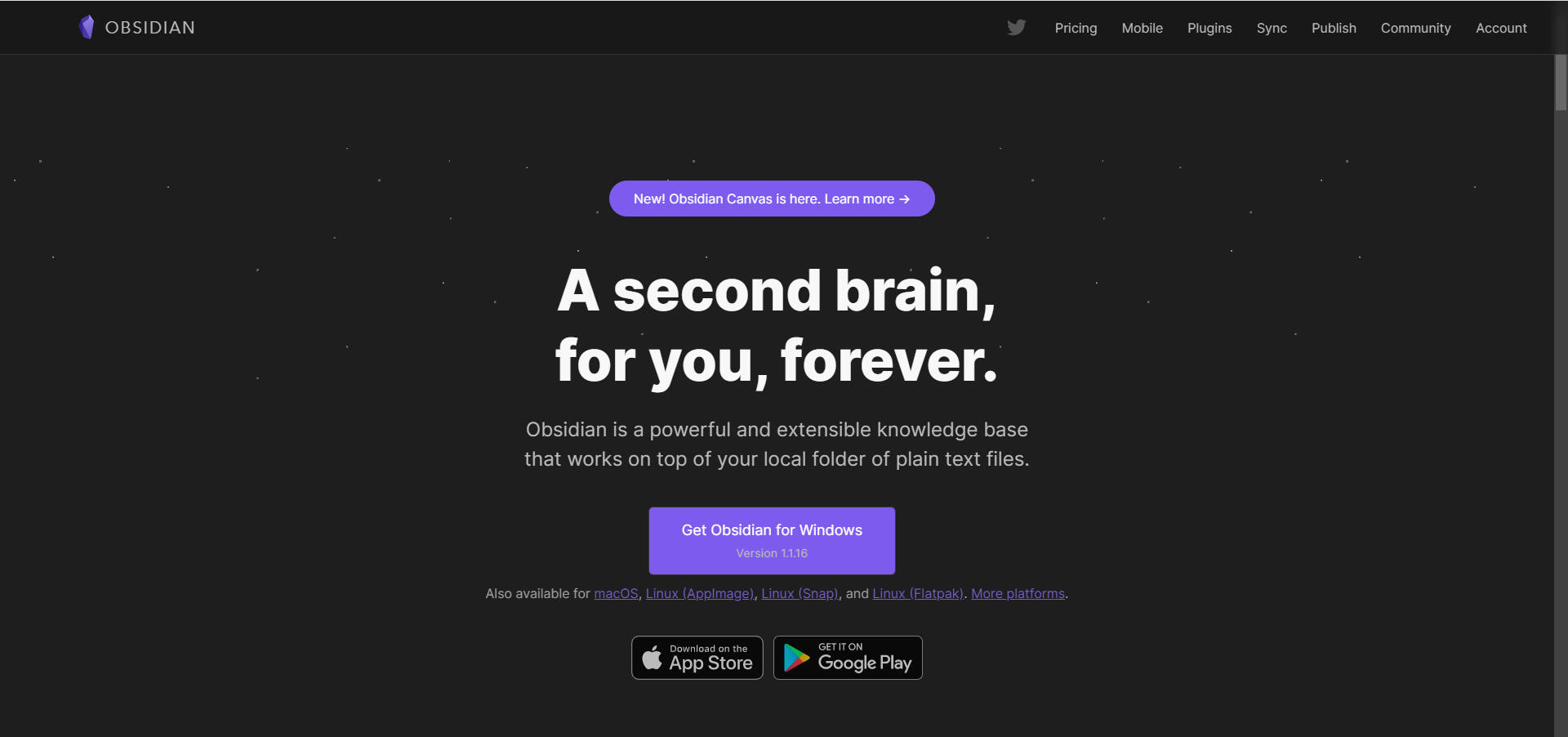
Click on the giant purple button to download it for your OS (It should auto-detect what you have). Once it's downloaded, open the file to install and YAYAYAYAYYAY!
Your computer now has Obsidian.
**2. Create a Vault**
Now, when you run Obsidian, you'll be prompted with this popup.
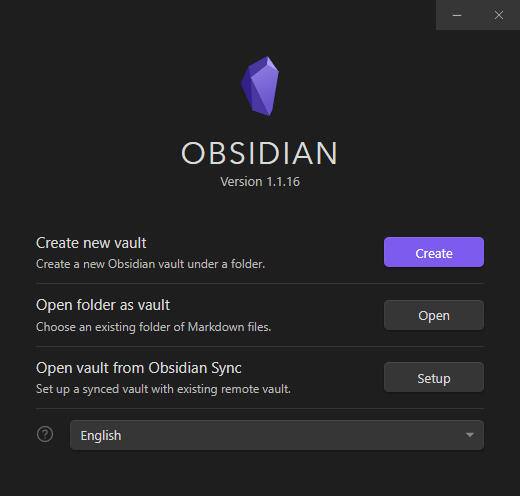
If you're wondering what a vault is, remember earlier we talked about how Obsidian saves your files locally on your computer?
So, a vault, essentially, is just a folder where Obsidian will keep all your notes.
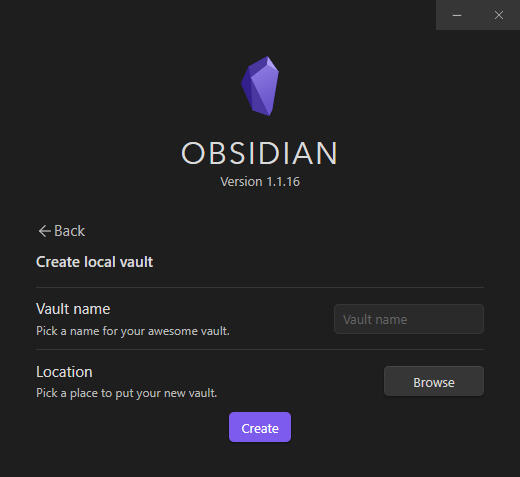
On the next screen, for the Vault name, write "The Best School Zettelkasten" ever made or something.
You can always change it later.
Then, click browse to pick the location on your computer where you'd like all your notes to be saved.
And congratulations! You're Obsidian is live!
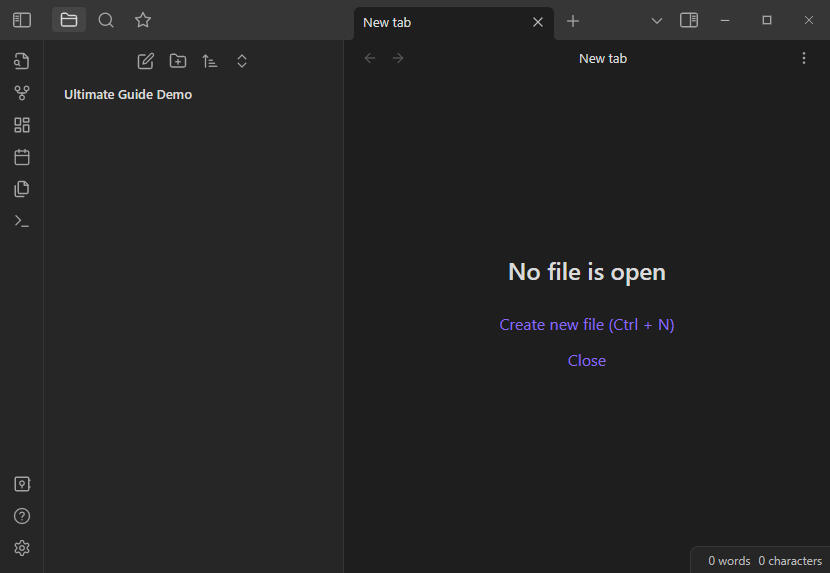
Now let's create seven folders inside of your vault.
To create folders, click the folder creation button shown below.

Create folders titled, +Encounters, Atlas, Calendar, Concept Notes, Literature Notes, Extras, and Spaces.
Your folders will look slightly differently than this because I have the make.md plug in installed allowing me to order folders differently, but the functionality will be the same.

The +Encounters folder is where all of the new notes you create will automatically go. It's your encounter station for new ideas.
Atlas: helps me gather, develop, and navigate ideas. It contains my Maps of Content ([[MOC]]s), dashboards, overviews, logs, and datascopes.
Calendar: helps me log, track, and review what matters to me. It contains my time-based information like daily notes, meetings, plans, reviews, and journals.
Concept Notes: This folder contains all of my concept notes, typically referred to as permanent notes in the community.
Literature Notes: contains all of my literature notes from the resources I consume. Notes on articles, books, podcasts, research papers, courses, talks, Movies+TV, videos, and Tweets.
Extras: helps me keep my support material handy. It contains attachments, graphics, images, manuals, and templates.
Spaces: helps me keep track of my most important areas of life, schoolwork, and the things I create from my notes for content creation.
Remember, this is the structure I use to create my Zettelkasten. But that doesn't mean a different structure won't work for you. **It's essential you play and change this structure to fit your needs.**
Here's one thing I wish I had known about the PKM earlier: **80% of the results are gotten with 20% of a tools capabilities.**
To do well in Obsidian you just need to bring the right mindsets, understand the Zettelkasten workflow I will describe in part 2 and 3, and some understanding of the tool itself.
*You don't need to create a complex tagging, folder, and quiering system, that's procrastination.*
# 🚀The Two Core Processes Through Which The Zettelkasten Works
The Zettelkasten works through two core processes, idea emergence and collect, connect, create.
You can think of idea emergence as the vertical ideation process and collect, connect, create, as the horizontal ideation process. Together they will supercharge your notetaking to unimaginable levels.
## Idea Emergence
The vertical process through which the Zettelkasten works comes from a term in [The Linking Your Thinking Workshop](https://www.linkingyourthinking.com/) that Nick Milo coined called idea emergence.
Idea emergence is the process through which new ideas emerge out of the connection of many ideas together. In systems thinking this is called [[Emergence]], when the whole is different from the sum of its parts. Idea emergence is how you differentiate yourself from the other cookie cutter students in school by coming up with new ideas.
**Understanding idea emergence is essential because it's how the entire Zettelkasten system of notetaking operates.**
So what does idea emergence look like?
Below is a graphic from [The Linking Your Thinking Workshop](https://www.linkingyourthinking.com/) which showcases it very well:

As you can see there are five levels to Idea Emergence.
### The Five Levels of Idea Emergence
_Please keep in mind that all the images used here are from Nick Milo's [Linking Your Thinking Workshop](https://www.linkingyourthinking.com/). All credit goes back to the original creator._
#### **Emergence Level 1: Creating Isolated Notes**
Emergence level 1 comes from collecting from the realm of ideas, lectures, textbooks, podcasts, books, etc.
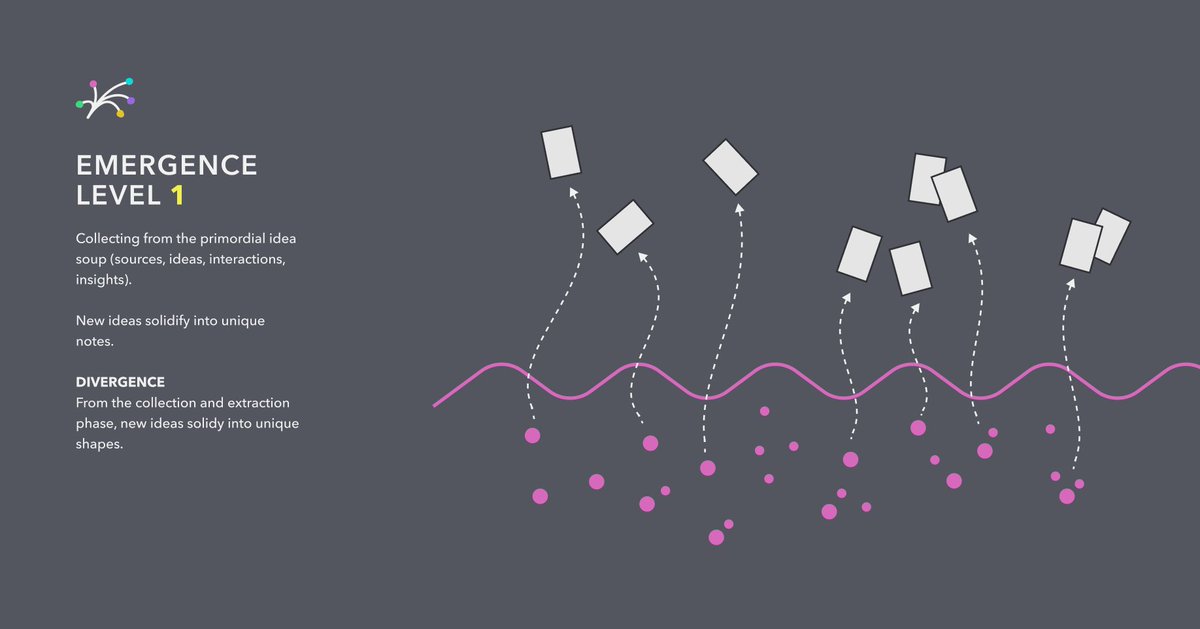
#### **Emergence Level 2: Growing And Connecting Your Notes**
At this level, notes start to link to other notes.
You have gone into your system and purposefully grown the individual notes you have to connect to other related notes.
Relationships form.
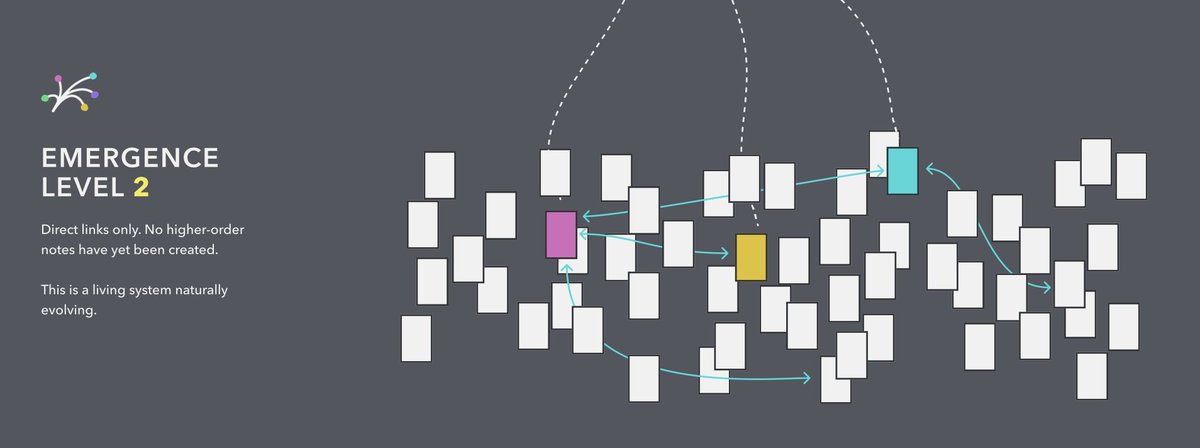
#### **Emergence Level 3: Creating The MOC**
At this point, you will want a bird's eye view of the relationships between the notes you are connecting.
You hit your [[Mental squeeze point]], the point at which the level of disorganization becomes uncomfortable.
**This is when the MOC creation process begins.** MOCs are a term coined by Nick Milo that stand for Maps of Content. They are essentially notes with a ton of other notes inside of them. We will talk about them more later. The creation of the MOC itself takes place over three steps which is conveniently the [same three-step process I use to write anything in record time](https://www.aidanhelfant.com/p/a632f0e4-6d32-4eb8-99f9-cf34390b2820/):
1. Dump
2. Lump
3. Jump
#### **Emergence Level 4: Linking MOCs Together-MOCSEPTION**
**At this level MOCs are linked to MOCs!**
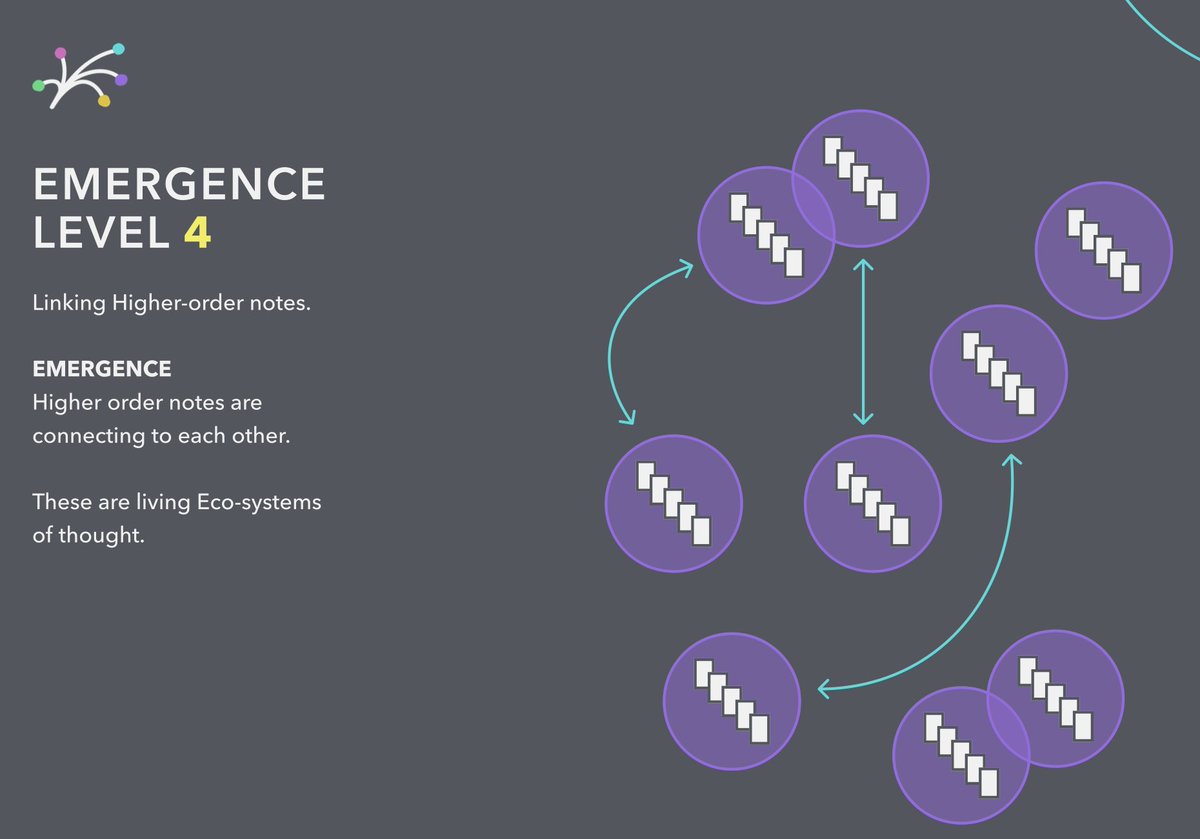
#### **Emergence Level 5: Creating A Home Note**
The highest level of emergence comes when you create a Home Note, essentially a MOC with all of your highest-order MOCs.
**The home note is your beginning, end, launchpad, and homebase.**
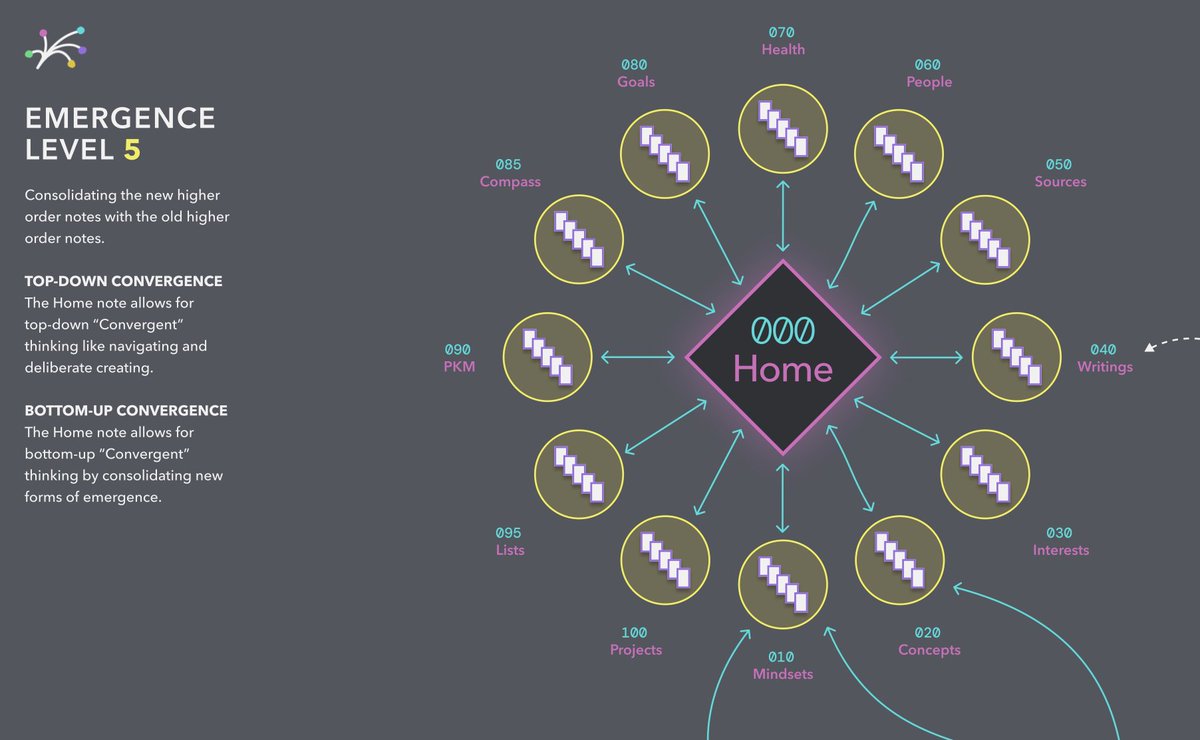
These five levels of emergence are the main process through which idea emergence happens in your Zettelkasten.
## Collect, Connect, Create
The horizontal Zettelkasten process in Obsidian, for me, works through three steps, collect, connect, and create. Call it the creative process, the knowledge process whatever you want. The idea is the same.
**You collect information that resonates with you over time, connect it to old information, and than create things out of it.**
Collect, connect, create, and idea emergence combine to form the ideation process.
We will be diving much more in depth into each in the coming emails but for now it's good you know what they stand for.
### Bottom Up And Top Down Thinking
This system of notetaking allows for both bottom up and top down thinking.
Bottom-up thinking involves taking notes at the individual level, relating them to old notes, and then growing them over time to create something entirely new. Top-down thinking involves combining individual notes into a MOC or a project. It's important to distinguish between the two types of thinking because people differ on which type of thinking they like more, and the methods to do each are very different.
Usually people are either more bottom up or top down.
School personally pushes on us a heavy top down mode of thinking which probably accounts for why I have a pretty bottom up approach to notetaking myself. But luckily the five levels of idea emergence allows you to do both bottom up and top down thinking at the same time. You can takes notes bottom up at the individual note level or connect them together into MOCs at the top down level.
[If you want to learn this process more in depth I suggest checking out article 5 Simple Levels To Supercharging Your Learning With MOCs In Obsidian.](https://www.aidanhelfant.com/p/3df1aef4-635b-408b-98fd-b6e1cccc338e/)
🎊Congratulations, in just a few minutes of reading you have learned the basic ways through which the Zettelkasten works inside of Obsidian.🎊 You're one step closer to making the transformation to The New Era Student. But you're not done. Check out part 2 of this series to learn:
- The Five Mindsets You Must Have To Create A Zettelkasten
- The Zettelkasten Workflow In Obsidian: Idea Emergence, and Collect, Connect, Create
If you want to learn more about how to implement this system for school, check out my and fellow Obsidian creator John Mavrick's flagship notetaking course Obsidian University: Your Secret Weapon In School. In it, you will:
- **Learn how to find enjoyment in learning and studying** by breaking out of the Cookie Cutter Mindset
- Flesh out a **systemized process** for taking notes on class lectures and outside learnings
- Create a **unique personal knowledgebase** inside Obsidian that scales across classes and semesters
- Learn how to navigate the overwhelming level of information and **overcome FOMO**
- **Learn how to study** using your Obsidian notes
- **Gain access to a community discord** with fellow students looking to make the same transformation
[Join the new Student Era today by checking out the course or signing up for one of my free email courses related to the course on the landing page.](https://shop.johnmavrick.com/obsidian-university?ref=aidanhelfant.com)